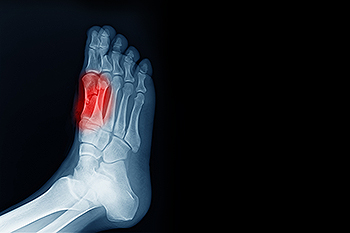
The two small bones in the ball of the foot under the joint of the big toe are referred to as the sesamoid bones. One is located on the outside of the foot, and the other is located closer to the center of the foot. Sesamoiditis occurs when the tissue that surrounds the sesamoid bones becomes inflamed and irritated. Sesamoiditis is considered to be a form of tendonitis, and can cause severe pain and discomfort. This generally happens from overuse and repeated pressure that is placed on the forefoot. The sesamoid bones absorb impact, and are responsible for helping the big toe move up and down during activity. Some of the symptoms that are associated with sesamoiditis can include foot pain that does not diminish, and the big toe may become stiff. People with increased chances of developing sesamoiditis include dancers, runners, and women who wear high heels. Effective treatment can begin with stopping the activity that caused this condition, resting the affected foot as often as possible, and possibly taping the big toe. If you have this ailment, it is strongly advised that you are under the care of a podiatrist who can help you with treatment options that are right for you.
Sesamoiditis is an unpleasant foot condition characterized by pain in the balls of the feet. If you think you’re struggling with sesamoiditis, contact Dan Kirk, DPM of Bluffton Foot & Ankle. Our doctor will treat your condition thoroughly and effectively.
Sesamoiditis
Sesamoiditis is a condition of the foot that affects the ball of the foot. It is more common in younger people than it is in older people. It can also occur with people who have begun a new exercise program, since their bodies are adjusting to the new physical regimen. Pain may also be caused by the inflammation of tendons surrounding the bones. It is important to seek treatment in its early stages because if you ignore the pain, this condition can lead to more serious problems such as severe irritation and bone fractures.
Causes of Sesamoiditis
- Sudden increase in activity
- Increase in physically strenuous movement without a proper warm up or build up
- Foot structure: those who have smaller, bonier feet or those with a high arch may be more susceptible
Treatment for sesamoiditis is non-invasive and simple. Doctors may recommend a strict rest period where the patient forgoes most physical activity. This will help give the patient time to heal their feet through limited activity. For serious cases, it is best to speak with your doctor to determine a treatment option that will help your specific needs.
If you have any questions please feel free to contact our offices located in Bluffton and Celina, OH . We offer the newest diagnostic and treatment technologies for all your foot and ankle needs.
